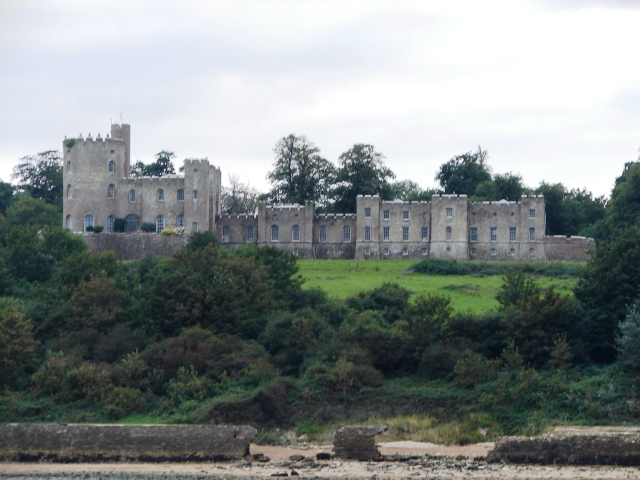An application has been made for a major redevelopment at Norris Castle in East Cowes on the Isle of Wight. Norris Castle has a Grade I registered landscape (RPG) and sits within the Isle of Wight Area of Outstanding Natural Beauty (AONB). It is flanked by the grounds of Osborne Castle (registered at Grade II*) and the Springhill Estate. The Gardens Trust has lodged a strong objection to the proposals, which we regard as a harmful overdevelopment of this highly significant and largely unaltered historic designed landscape.
Major redevelopment scheme
The developer proposes to do the following:
- open up an access route to Norris Castle through the Springhill Estate via the Esplanade
- build a residential development on the Springhill locally listed historic parkland
- create a viable hotel from Grade I listed Norris Castle by adding subterranean terraces
- create a Spa Resort in the Grade I listed farmstead, converting the existing buildings into resort residences and adding 13 new resort cottages in the walled Kitchen Garden
- create semi-buried resort lodges in the Grade I estate, three-storey resort terraced townhouses in place of the modern barn by the farmstead, four resort ‘farm-workers’ cottages, coastal resort cottages, and four Sentinel resort apartment blocks and a restaurant on the sea wall
- build a residential complex of large houses in the field adjacent to the south lodge
- create three car parking areas.
Historic England said: “Norris Castle is of outstanding importance as a particularly beautiful and unusually well-preserved picturesque ensemble of house, landscape and ancillary buildings. The current proposals would entail a very high degree of harm to its significance.” They regard the scheme as a “very inefficient means of raising the money necessary to repair the buildings” as the developer’s profit (around £22 million) and development costs are out of all proportion to the estimated repair costs of £16.55 million. Historic England anticipate objecting to the proposals, but are awaiting additional information, including an independent assessment of the viability of the proposed scheme, before issuing their definitive advice.
Gardens Trust response
There are significant problems with the proposal in terms of increased vehicle access to the site, the scale and position of the substantial housing developments, the plans for the conversion of Norris Castle and farmstead and the impact on its Grade I-designated parkland.
In the planning response from the Gardens Trust, Conservation Officer Margie Hoffnung pointed out the exceptional historic significance of the site. The Springhill and Norris Castle estates represent a substantial area of virtually untouched landscape recognised for its picturesque views, especially to and from the Solent and Spithead, for at least the past 200 years. Norris Castle also has significant “group value as the castle, model farm and designed landscape create an extremely fine example of Picturesque landscape style, crucially remarkably unchanged since its creation around 1799…[The] ornamental pleasure grounds and park are likely to be have been laid out by Humphry Repton, as a landscaped setting for a marine villa built in the form of a Gothic castle designed by James Wyatt, and a castellated model farm following the traditions of a ferme ornée.”
Issues with Norris Castle application
We welcome the restoration proposals, which include work on the listed buildings, walled garden, parkland, the opening of vistas and management of the woodland. However, given the significance of Norris Castle and Springhill, our response particularly highlighted the following issues with the application:
- the large scale of the proposed development which will irrevocably alter the character and spirit of place of both Norris Castle and Springhill
- the effect of the Sentinel buildings on the structure of and views from the sea wall, whose proposed restoration is in direct conflict with the Isle of Wight Council’s Shoreline Management Plan
- misleading statements about the need to stabilise the slope below the castle
- the harmful impact of the Terrace and Crescent developments on the setting of the castle and its RPG
- the absence of wire frame photo-montages from several crucial viewpoints to establish how visible the numerous newly-built structures would be within the Norris Castle estate and in views from the sea
- the increased prominence within the landscape of the new developments and their associated access roads following vegetation clearance
- light pollution in the hitherto dark night sky from houses, resort accommodation and cars
- lack of public access to what would essentially be a private gated community; only a few hectares within Springhill will be open to the public.
Cumulative impact on Norris Castle
Margie Hoffnung concludes that the proposals fail to comply with the National Planning Policy Framework: “the development within Norris Castle estate will so change the character of the RPG that future generations will no longer be able to appreciate its contribution to the quality of life as originally designed.” Nor does the development “make a positive contribution to local character and distinctiveness”. In particular, the cumulative harm of the plans “is particularly high given the significance of the historic assets affected as an ensemble. It is the degree of harm to the asset’s significance as a whole rather than the scale of the individual areas of development that we feel should be considered.”
While we want to see a solution for the problems of Norris Castle, the current proposals, in our opinion, are not the answer.
Norris Castle planning application
View of Norris Castle from the sea Credit: Mark Pilbeam, CC BY-SA 2.0, via Wikimedia Commons




